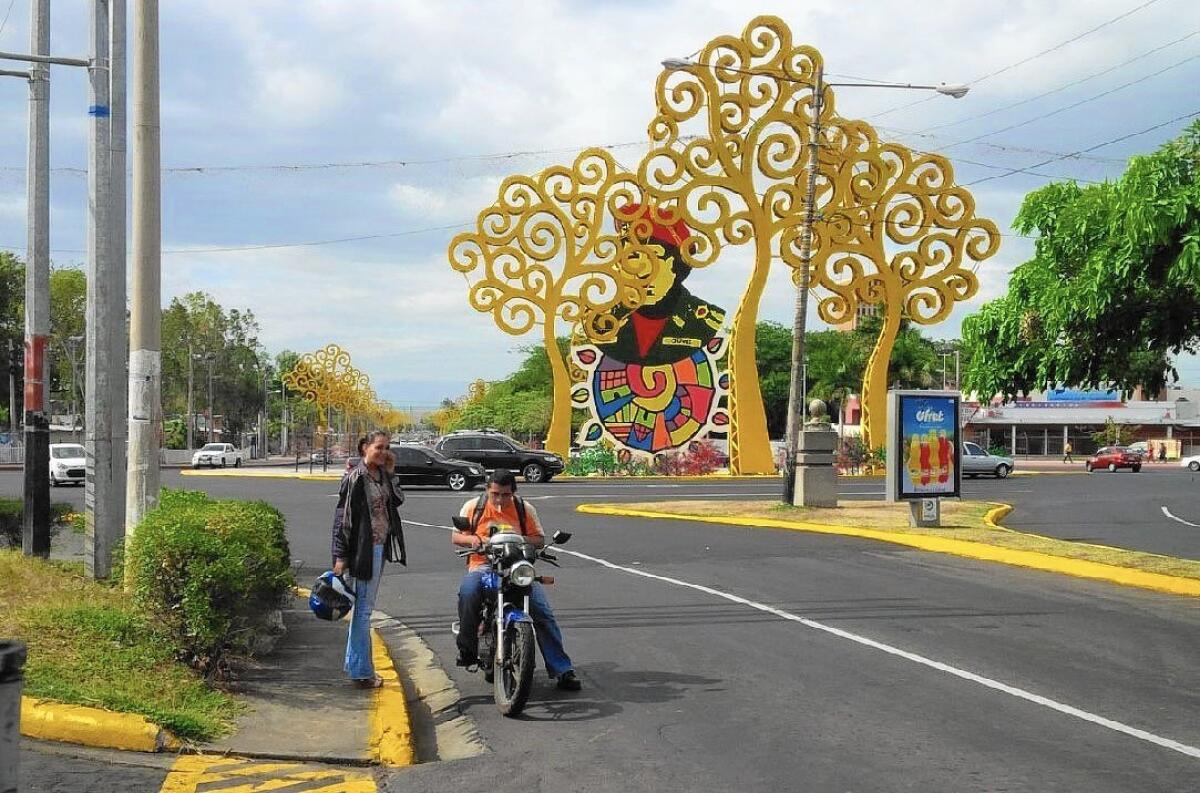Nicaragua’s first lady is a powerful partner of president

- Share via
Reporting from Managua, Nicaragua — Along Hugo Chavez Boulevard in what might pass for downtown Managua, there stands a curious mini-forest of gigantic fake trees. They are saffron in color, each a mass of abstract curlicues, and at night they glow.
They are called the Trees of Life, and they are but one of the bizarre gestures by Rosario Murillo, the omniscient and omnipotent wife of President Daniel Ortega.
She apparently sees something mystical in them, part of her quasi-New Age, quasi-socialist, quasi-Christian view of the world. She has erected dozens of the trees around Managua, a shambolic capital where ruins from a devastating 1972 earthquake compete for space with sprawling ticky-tacky shopping malls.
Once a revolutionary poet of modest success, Murillo today is Nicaragua’s most powerful woman and, in the opinion of many, essentially a co-president with her husband. The arrangement, opponents say, allows the first couple to consolidate power and wealth and rule the country like a personal fiefdom.
Ortega, a fiery leader of the Sandinista revolution that came to power in 1979 and now a balding president who appears fond of nepotism, is often reticent when it comes to speaking in public. But Murillo is happy to hold forth — on daily radio broadcasts and in regular barrages of emails, though not to Western journalists asking for comment or a meeting.
Wherever he goes, she is there, from state visits by Russian leaders to international summits. Her formal title — communications minister — is one she created for herself, and she reportedly will not permit any other minister to speak on behalf of the government.
“It’s a two-headed government,” said Jaime Morales, who served as Ortega’s vice president from 2007 to ’12. “If he’s the head of state, she’s the prime minister in complete collaboration.”
With a mane of messy, dark curls, a clothing style that can best be called Bohemian Tropical and numerous necklaces, bracelets and a ring (or several) on every finger, Murillo makes for one of the oddest first ladies in a long time. She is superstitious (many of the rings contain turquoise, said to ward off evil spirits), refuses to live in the presidential residence because she reportedly thinks it’s haunted and often invokes God, Mother Earth and the spirit of Chavez, Venezuela’s late socialist leader.
Her Trees of Life, many Nicaraguans say, are like symbolic billboards promoting her position and mystic allegiance. They cost $20,000 apiece and run up $10,000 monthly in electrical bills, the independent news organization Confidencial reported.
The trees are said to be patterned after a biblical reference: “And out of the ground the Lord God made to spring up every tree that is pleasant to the sight and good for food. The tree of life was in the midst of the garden ...” (Genesis 2:9).
In addition to the trees, these days there is a new abundance of posters, tacked to light poles, street signs and fence posts, in which Murillo is depicted without Ortega by her side. The president manipulated Nicaragua’s congress and courts to change the law and permit him to run for reelection indefinitely. But amid rumors that his health is failing, it may be Murillo’s turn to take over formally.
After Ortega lost a presidential election in 1990, and then repeatedly thereafter, he and Murillo abandoned their professed revolutionary convictions for the rhetoric of family and Christianity, politically appealing in the impoverished and poorly educated country. They returned to power with the 2006 elections.
Governing has become quite the family affair since then. Ortega, who has seven children with Murillo, has named his sons and daughters as ambassadors and special presidential advisors, or given them state companies. One son is in charge of negotiating with China to build a $50-billion canal across Nicaragua’s midsection.
The specter of dynastic rule is especially troubling in a country that remembers the four-decade Somoza family dictatorship of the 20th century, when father and then son governed with a heavy hand — until overthrown by the Sandinistas.
Ortega also recently named Murillo “foreign minister at large.”
Murillo began taking a front-row seat in Ortega’s public affairs in 1998, after her daughter from a previous relationship (whom Ortega adopted) accused him of systematic sexual abuse over a period of years. Ortega denied the charges, and Murillo sided with her husband against her daughter.
Some in Nicaragua have speculated that the quid pro quo, acknowledged or subliminal, was Murillo’s rise to power.
The Ortega-Murillo team has changed its colors, ideologically and literally. Fuchsia and baby blue are the new red and black, chosen by Murillo to replace the ubiquitous revolutionary colors that represented the Sandinista government and all its institutions in the 1980s.
Their new slogan for Nicaragua: Christian, Socialist and United.
Murillo’s invocation of God, which even the trees echo, is especially curious, given that the original Sandinista National Liberation Front was officially atheistic. Bishop Silvio Baez, one of the top officials in the Roman Catholic Church in Managua, accused Murillo of using religion to “humiliate and dominate” the people of Nicaragua.
Former veteran Sandinistas say today’s version with Ortega and Murillo has little to do with the cause they fought for and represented. Instead of “Sandinismo,” a reference to a 1930s revolutionary hero who battled the U.S. Marines, they call today’s ruling movement “Orteguismo” or “Danielismo.”
And, maybe soon, “Rosarioismo.”
Twitter: @TracyKWilkinson
More to Read
Sign up for Essential California
The most important California stories and recommendations in your inbox every morning.
You may occasionally receive promotional content from the Los Angeles Times.











